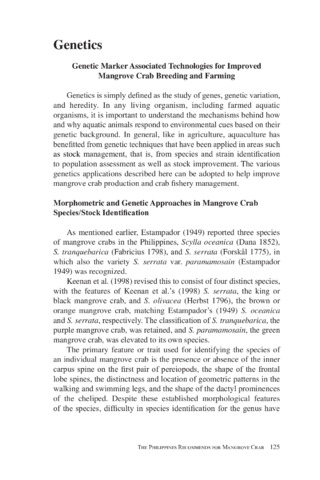Induction of moulting in hatchery-reared mangrove crab Scylla serrata juveniles through temperature manipulation or autotomy
| dc.contributor.author | de la Cruz-Huervana, Joana Joy Y. | |
| dc.contributor.author | Quinitio, Emilia T. | |
| dc.contributor.author | Corre, Valeriano L. | |
| dc.date.accessioned | 2019-09-19T01:46:20Z | |
| dc.date.available | 2019-09-19T01:46:20Z | |
| dc.date.issued | 2019 | |
| dc.identifier.citation | de la Cruz-Huervana, J. J. Y., Quinitio, E. T., & Corre, V. L. (2019). Induction of moulting in hatchery-reared mangrove crab Scylla serrata juveniles through temperature manipulation or autotomy. Aquaculture Research, 50(10), 3000-3008. | en |
| dc.identifier.issn | 1355-557X | |
| dc.identifier.uri | http://hdl.handle.net/10862/3523 | |
| dc.description.abstract | The effects of temperature and autotomy of chelipeds on survival, growth and moulting of mangrove crab (Scylla serrata) juveniles were investigated under laboratory conditions for 60 days. Hatchery‐produced crabs with 2.0–2.3 cm internal carapace width (1.7–2.2 g body weight) at intermoult stage were exposed to one of four temperature treatments (constant 29, 32 or 35°C, or ambient [24–31°C]) or subjected to cheliped autotomy. All crabs held at 35°C had 100% mortality due to incomplete moulting during first moult. The mean survival of crabs at termination was 58%, 64% and 50% for ambient temperature, 29 and 32°C respectively. Specific growth rate (SGR) of crabs in the ambient and 29°C were comparable but significantly lower than those at 32°C. The moult interval of the crabs was significantly shorter in treatments with constant water temperature of 29 and 32°C compared with ambient temperature. The survival of crabs with intact chelipeds was comparable with those with one or two autotomized chelipeds. Crabs with intact or one autotomized chelipeds had significantly higher SGR than crabs with both chelipeds autotomized in the first moult. On the second moult, however, high SGR was observed in crabs with two chelipeds autotomized. The moult interval was significantly shorter in the autotomized crabs compared with crabs with intact chelipeds. The results suggest that the optimum water temperature for rearing S. serrata juveniles ranges from 29 to 32°C. Likewise, autotomy of chelipeds can promote moulting without adversely affecting survival of crabs. | en |
| dc.publisher | Wiley | en |
| dc.subject | Scylla serrata | en |
| dc.subject | Decapoda | en |
| dc.subject | Cheliped autotomy | en |
| dc.subject | Mangrove crab | en |
| dc.subject | hatcheries | en |
| dc.title | Induction of moulting in hatchery-reared mangrove crab Scylla serrata juveniles through temperature manipulation or autotomy | en |
| dc.type | Article | en |
| dc.identifier.doi | 10.1111/are.14257 | |
| dc.citation.volume | 50 | |
| dc.citation.issue | 10 | |
| dc.citation.spage | 3000 | |
| dc.citation.epage | 3008 | |
| dc.citation.journalTitle | Aquaculture Research | en |
| dc.subject.asfa | aquatic crustaceans | en |
| dc.subject.asfa | growth rate | en |
| dc.subject.asfa | brackishwater crustaceans | en |
| dc.subject.asfa | behaviour | en |
| dc.subject.asfa | juveniles | en |
| dc.subject.asfa | water treatment | en |
| dc.subject.asfa | temperature | en |
| dc.subject.asfa | survival | en |
| dc.subject.asfa | water temperature | en |
| dc.subject.asfa | rearing techniques | en |
| dc.subject.asfa | body weight | en |
| dc.subject.asfa | moulting | en |
| dc.subject.asfa | marine crustaceans | en |
| dc.subject.asfa | autotomy | en |
| dc.subject.asfa | hatching | en |
| dc.subject.asfa | mangroves | en |
| dc.subject.asfa | temperature effects | en |
| dc.identifier.essn | 1365-2109 | |
| dc.subject.scientificName | Scylla serrata | en |
Files in this item
| Files | ขนาด | รูป | View |
|---|---|---|---|
|
There are no files associated with this item. |
|||
รายการนี้ปรากฏใน (s)
-
Journal Articles [1258]
These papers were contributed by Department staff to various national and international journals.




